Change Management & Controlled Rollouts
Funnels every change through an automated gate so only verified code reaches production.
What it is
Change management at Jeeva AI is a gated conveyor belt that moves code, configuration and infrastructure from idea to live traffic with the minimum possible surprise. Every modification—whether a new campaign algorithm, a library patch or a Terraform tweak—follows the same lifecycle: proposal, peer review, automated testing, staged deployment, production verification and post-deployment audit. The pipeline is expressed as code, version-controlled in the same repositories as the application, and enforced by continuous-integration jobs that refuse to proceed when prerequisites are missing.
Why it matters
Enterprises trust vendors that can evolve rapidly without destabilising regulated workloads. A single mis-configured permission or un-vetted dependency can halt prospect outreach, skew attribution models or violate data-handling obligations. By hard-wiring discipline into the release train, Jeeva AI protects customer uptime, preserves data integrity and produces machine-readable evidence for SOC 2, ISO 27001 and internal audit teams. The payoff is dual: features ship faster because decisions are automated, and risk diminishes because every step is visible, replayable and revertible.
How a change moves through the system
Initiation
A developer starts with a feature branch whose name encodes the Jira ticket ID. Creating that branch triggers a background job that attaches a checklist template: licence-scan results, predicted cloud-spend deltas and any need for third-party vendor onboarding. If a new supplier is involved, the branch cannot merge until a digital Vendor Assessment Questionnaire returns “approved”; the CI job checks the vendor inventory through an API call before green-lighting the pipeline.
Peer review and automated gates
When code is ready, a pull request opens against the development branch. The rules engine enforces dual control—at least one reviewer outside the author’s functional squad—and runs static analysis, dependency CVE scans, unit tests and OWASP dependency checks. If the change touches persistent storage, migration scripts must include down-migrations; the CI suite spins up a disposable database, applies migrations up and down, and fails if reversibility breaks.
Build and signature
Passing reviews allow the pipeline to build an immutable container. A signing service injects a SHA-256 digest into the image label and stores the signature hash in an attestation ledger. Kubernetes admission controllers later verify this signature before admitting the pod, blocking unsigned or tampered artefacts.
Staging and canary
The container first lands in a staging namespace that mirrors production quotas and secrets through sealed-secret manifests. Integration tests fire synthetic outreach sequences against sandbox CRM and email accounts; result thresholds must meet or exceed baselines before promotion. Promotion copies the image to a canary environment wired to one percent of real tenant traffic under a feature flag set to “observe.” Service-mesh telemetry compares latency, error rates and business KPIs against the control cohort. Divergence beyond pre-set SLO budgets rolls the change back automatically and re-opens the pull request with diagnostic attachments.
Progressive release
Success advances the rollout to five, twenty and finally one-hundred percent over configurable intervals. Customers that have enabled sandbox mode can opt in earlier; others see the change only after the flag defaults to “on.” Release notes, documentation updates and enablement videos publish through the same pipeline, ensuring that support teams and customer administrators receive synchronized information.
Hotfixes—without side doors
When a critical vulnerability or availability issue emerges, the same conveyor belt accelerates but never bypasses controls. A hotfix branch spawns from the production tag, undergoes automated tests tuned for speed, and enters a dedicated hotfix pipeline with shortened but still mandatory review. The result is blast-radius containment in hours, not days, without compromising auditability.
Audit logging and retrospectives
Every pipeline action—review sign-off, test suite result, deployment hash, flag flip—is streamed to the immutable event ledger. Quarterly, an automated job extracts all change records, signs them and stores an encrypted snapshot for external auditors. When incidents occur, the Incident-Response Plan requires responders to reconstruct the timeline from these canonical logs before touching live systems.
Feedback into planning
Post-deployment metrics feed back into Jira via web-hooks. If a feature under-performs, product managers see real-time adoption curves; if infrastructure changes increase cost, finance dashboards highlight the delta. Lessons surface in fortnightly retrospectives, and improvement items enter the backlog with the same traceability as new features.
Outcome
The net result is a living release engine that blends speed with safety. Developers merge confidently because automated guards stand watch; operations sleeps easier because every package is signed, staged, monitored and, if necessary, rolled back automatically. Customers experience steady innovation paired with the predictability large organisations need, and auditors walk away with end-to-end evidence that no code reaches production without passing through a rigorously documented, multi-layered control system.
